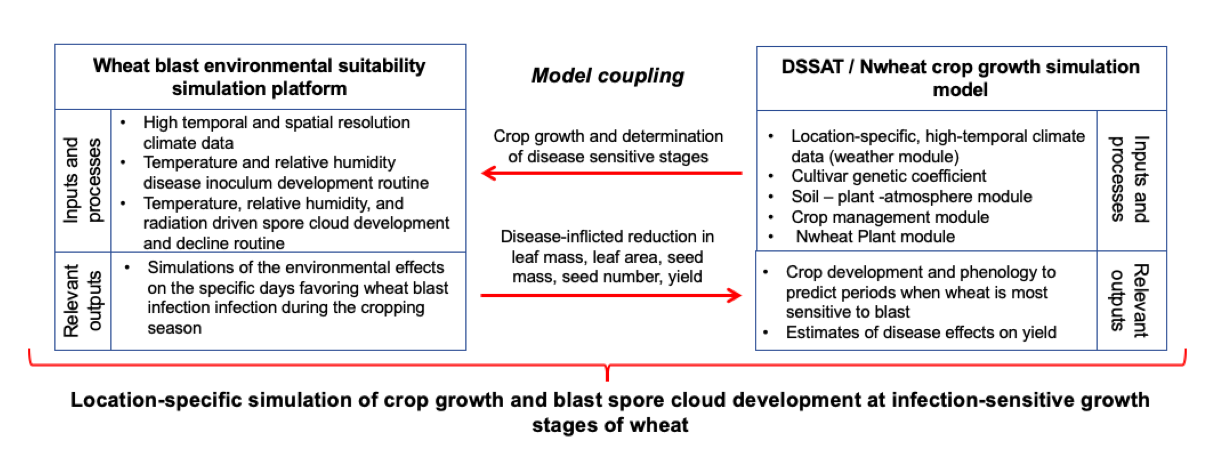Crop models can be useful tools to study crop and environmental interactions in a virtual setting. Crop models applications include study of the impacts of environmental factors such as climate change, climate variability, drought, and heat stress on crop production at different spatial and temporal scales. Alongside traditional field research, an improved understanding of the effects of these factors can be achieved using crop models capable of simulating different scenarios either for a single environmental factor (Asseng, 2015) or a combination of factors (Asseng et al., 2004). Models also permit researchers to simulate environmental and crop management effects at several locations or different crop developmental phases, or both. This part of the wheat blast early warning system integrates the disease environmental suitability assessments described by Fernandes et al. (2017) with a dynamic crop simulation model to predict specific periods of crop development when wheat may be most susceptible to disease infection.
Nwheat is a process-based simulation model that simulates wheat crop growth and development as a function of weather, soil characteristics, and crop management. Typically, Nwheat model estimates times at which specific growth stages are attained (e.g., flowering and physiological maturity) and biomass weight of the wheat plant components (e.g., leaves, stems, roots, and grains) as they change over time during the course of the cropping season. Nwheat also simulates the effects of changes in soil moisture content and nutrient status on these and other measurements. NWheat was recently embedded in the widely used simulation model ‘Decision Support System for Agrotechnology Transfer’, or DSSAT, Version 4.7 (Hoogenboom, et al., 2017). Nwheat also been has been tested under a number of crop production environments with different in temperature regimes, carbon dioxide levels, and variable soil nitrogen and moisture conditions (Kassie et al., 2016).
Wheat blast, caused by Magnaporthe oryzaepathotype Triticum, is a potentially severe disease that is established in South America and in Bangladesh (Cruz and Valent, 2017). Infections vary as a function of differing weather conditions, crop cultivars, location and time. The DSSAT-Nwheat model is currently under developer improvement to enable simulations that account for biotic stresses to crop growth, most notably for the damage imposed by diseases and pests. By coupling the Nwheat crop growth model with environmental disease suitability assessments, model users will eventually be able to explore the effect of a range of sowing dates, weather conditions, and cultivar effects on wheat blast infection. This will ultimately permit researchers to develop improved agronomic management recommendations to mitigate the effects of wheat blast in farmers’ fields. Here, we introduce a novel work to integrate the DSSAT-Nwheat simulation model with the weather-data driven wheat blast simulation model described by Fernandes et al. (2017) in both Brazil and Bangladesh.
The dynamic linkage between wheat blast infection and resulting crop injuries and the wheat crop is by coupling points between the wheat blast model and the wheat model. Coupling points are, places where the values of state variables – the variables that represent the state of the physical quantities being modeled – can be exchanged with other models. Examples of coupling point variables in this study include leaf mass or area and seed mass or number, both of which might be negatively impacted by wheat blast. By identifying specific mechanical and infection damage pathways, and rates of damage using these variables, growth models can be tuned to quantify how crop development and yield might be affected.

References
Asseng, S., Jamieson, P.D., Kimball, B., Pinter, P. and Sayre, K. (2004). Simulated wheat growth affected by rising temperature, increased water deficit and elevated atmospheric CO 2. 85: 85–102. doi: 10.1016/S0378-4290(03)00154-0.
Asseng, S. (2015). Rising temperatures reduce global wheat production. 5(December 2014): 143–147. doi: 10.1038/NCLIMATE2470..
Cruz, C. D. and Valent, B. (2017). Wheat blast disease: danger on the move. Trop Plant Pathol. doi:10.1007/s40858-017-0159-z.
Fernandes, J. M. C., Nicolau, M., Pavan, W., Hölbig, C. A., Karrei, M., de Vargas, F., Tsukahara, R. Y. (2017). A weather-based model for predicting early season inoculum build-up and spike infection by the wheat blast pathogen. Tropical Plant Pathology. https://doi.org/10.1007/s40858-017-0164-2.
Hoogenboom, G., C.H. Porter, V. Shelia, K.J. Boote, U. Singh, J.W. White, L.A. Hunt, R. Ogoshi, J.I. Lizaso, J. Koo, S. Asseng, A. Singels, L.P. Moreno, and J.W. Jones. (2017). Decision Support System for Agrotechnology Transfer (DSSAT) Version 4.7 (https://DSSAT.net). DSSAT Foundation, Gainesville, Florida, USA.
Kassie, B. T., Asseng, S., Porter, C. H., & Royce, F. S. (2016). Performance of DSSAT-Nwheat across a wide range of current and future growing conditions. Eur. J Agron. https://doi.org/10.1016/j.eja.2016.08.012.